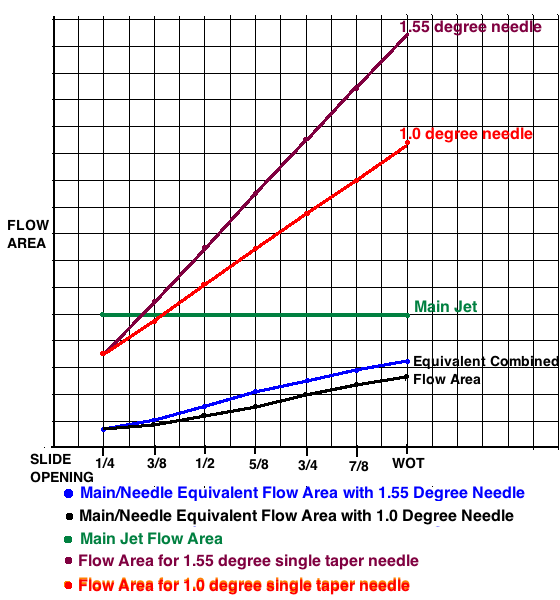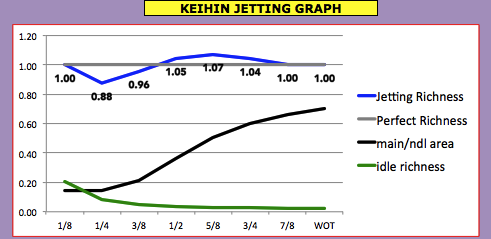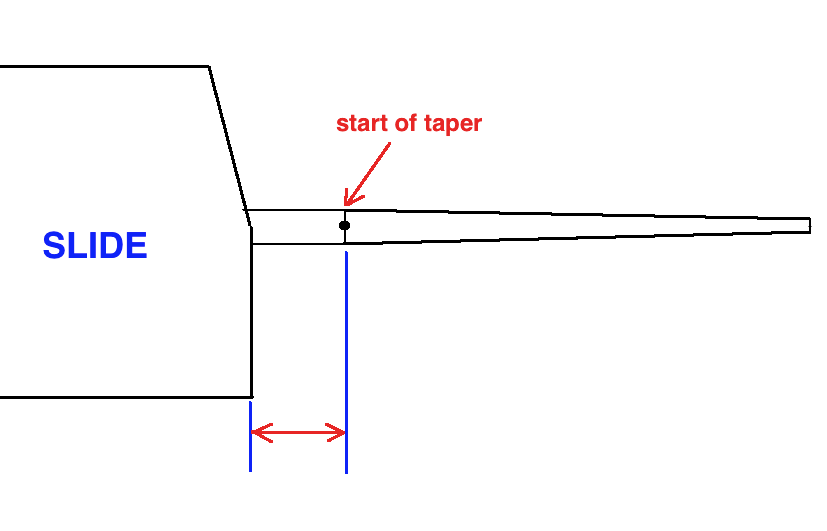All About Carb Jetting
This shows the two main types of needles. When selecting a needle the length of the straight section is just as important as the taper angle(s). Sometimes you can see that it is a double taper needle by holding a metal rulers edge up against the needles taperd portion. Typically the dual tapered needles are of the last type shown here which richen the jetting between closed and open throttle which is best for race bikes. 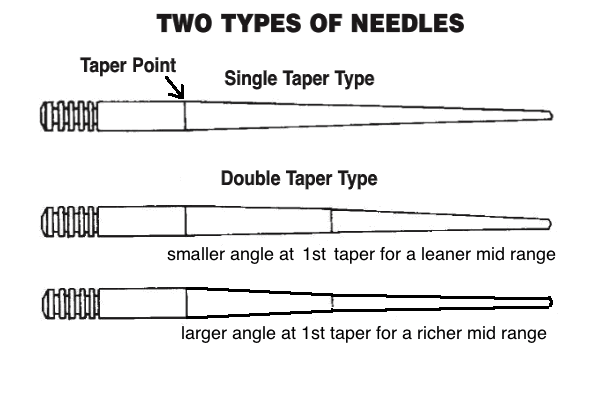 Measure the slide open height (from bottom of venturi) after you set it for a consistent idle. More than 11% of the carb bore (the carb size) means the idle jet may be too big for a reed valved engine. Under 11% may mean the needle jet is wallowed out and too much fuel is coming up from there into the carb venturi. [read more] Just multiply carb size by 0.11 to know the 11% distance. If you have lots of small sizes of allen wrenches you can use them to figure out the slide open distance by placing it under the slide (if it fits). Another way is to use your digital caliper to measure how far down from the carb top the top of the slide is at "closed" throttle. Then unscrew the slide stop screw (write down how many turns) till the slide bottoms out. Then remeasure how far down the slide is. The difference of the two measurements is the slide height at idle. 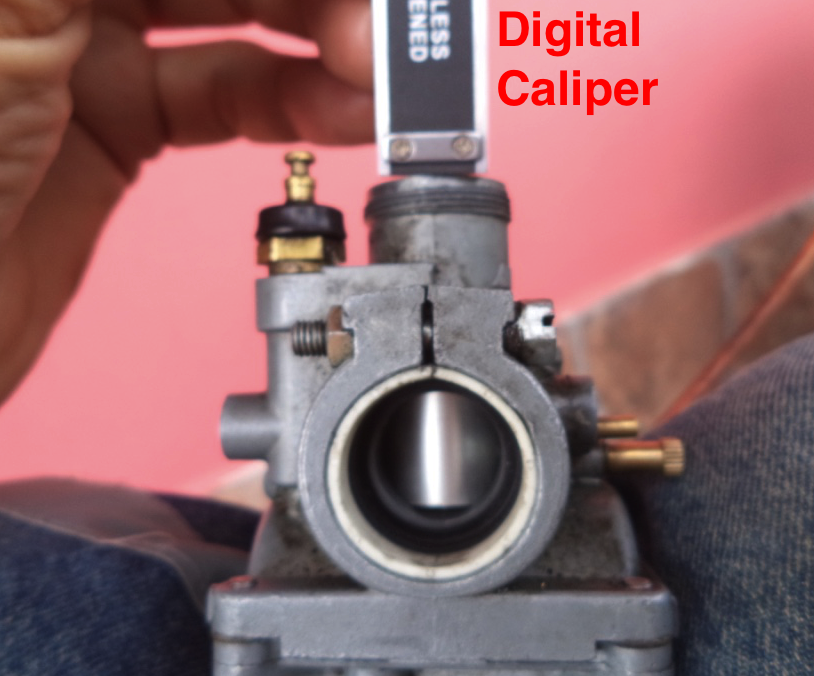 Two important measurements are the needle shroud height and the recess of the needle jet (atomizer) from the base of the venturi (A37 on the VM sheet). That last measurement is from the base to the narrowest opening of the jet. Notice that they curve right there so don't measure to the jets top. Normally it's around 2mm. 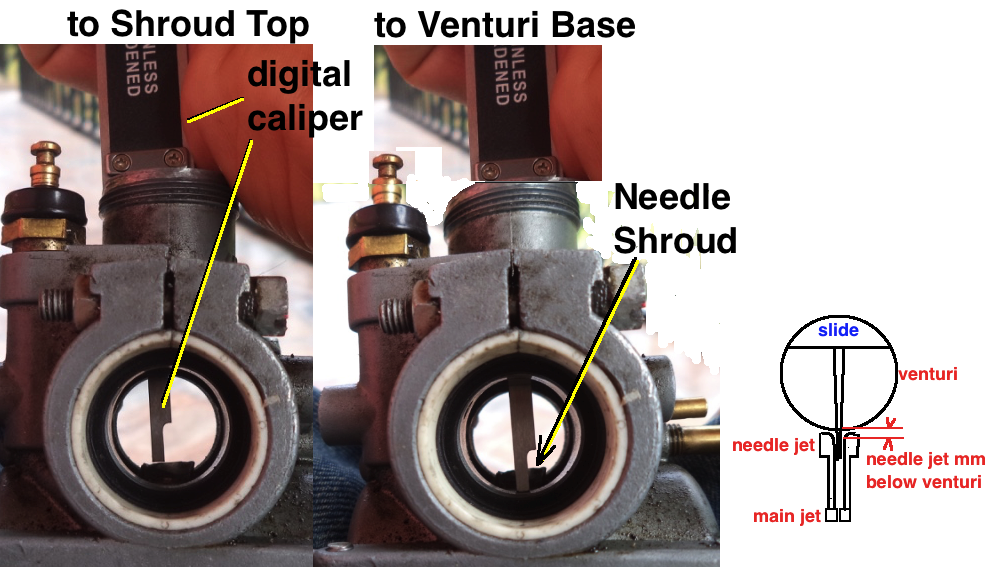 The measurement of the inlet bell diameter affects how much the idle jetting is still in effect at WOT. The bigger the diameter, the more it stays in effect which is why Dellorto's are much more that way than Mikuni VM's. 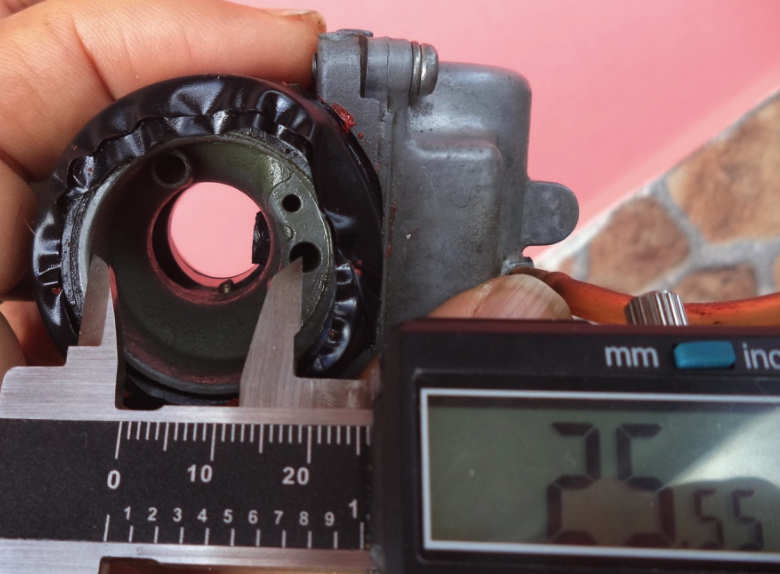 Important!: Most gas has 10% ethanol which causes your engine to run leaner. You need to know how much ethanol is in your gas to use my jetting calculator. You can test it yourself with an ethanol tester or look on the gas pump for the sticker revealing how much ethanol is in the gas. Here is a site that explains more about this topic: https://www.pure-gas.org/about After reading its page then click on "Stations" and then at the bottom of the page click onto the letters for your State to see which stations sell ethanol-free gas. All older bikes need to use ethanol-free gas for the longevity of the crank seals, carb float needle valve rubber tip, and gas lines (well you can buy ones that won't harden). Here's my page showing how to remove the ethanol: www.dragonfly75.com/moto/no-alcohol.html Bikes run stronger with ethanol-free gas and are jetted correctly. Please don't despair that this process is too tedious. It is detail oriented but that is what is necessary for selecting the perfect needle for your ride. The more needles you test on the spreadsheet the easier the process becomes. Then just wait for the smile on your face once you go riding again. It's just great to have a carb correctly jetted. Say goodbye to fouled plugs and seized cylinders! (that is if you heeded my advice on engine oil) The newest version 11 is now available but I haven't updated the instructions sheets for it. Click here for the video about it. The previous versions referenced idle jetting as the starting point for the graph but I decided to ditch that idea because 1) most riders have their own way of setting up their idle mix and may not want to adopt my method, 2) I finally realized there are some dimensional aspects to the idle fuel flow that I'm not engineer enough to fully grasp and that my formulas results for that may be too far off. So the new version keys off of the 1/8 slide open jetting which is easier to calculate. All the jetting sheets (other than Old Carbs which I haven't updated yet) now get some of their data from sheet 5, the Velocity sheet. So first go to the velocity sheet and enter all the data and then fill out the data cells in the upper righthand corner of the sheet. If you have two different setups for the same carb sheet then you should just resave the spreadsheet with a name that indicates the 1st setup and do that again for the 2nd setup. The TMX and Keihin sheets have two inputs that allow you to modify the graph results. The first is cell A7 (which is also on the other 2 sheets) which allows entry of a # that allows you to raise or lower the beginning of the graph. So if you know that low throttle opening jetting is too rich then enter a # higher than 1.0 with the idea that "obviously rich" is above 5% (over 1.05) richer on the graph, and obviously lean is under .95. Cell A9 on the TMX and Keihin sheets allows entry of a # that allows you to raise or lower the middle of the graph. So, for example, if you know it's too lean mid throttle, due to losing power when you crack the throttle wide open, but the graph doesn't show it to be low then you'd want to enter a # less than 1.0 to get the graph to look like how you feel it is in real life. Then by making virtual changes you hope to see the graph correct itself. Keep in mind that when we ride a street or trail bike that we rarely crack the throttle open suddenly like we would while racing. So mid throttle jetting for a race bike should be richer, like as much as 1.05 on the graph so that it won't bog when cracking it open. A street/trail bike should be real close to the graphs 1.0 which means it isn't rich mid throttle so that you don't quickly foul a plug from rich jetting as you ride around and just slowly open the throttle. This version can help you select a main jet because the WOT jetting should be between 49 and 51 on I15. If the # is lower than that then increase the main jet. If it is higher than that then lower the main jet. If you are certain about your main jet choice, not relying on plug color but on how it runs, and yours falls outside of that range then I want to know about it. The instructions for using the jetting calculator are at these web pages: Mikuni VM/TM Carbs, Mikuni TMS/TMX Carbs, Keihin Carbs, Dellorto Carbs, Other Carbs 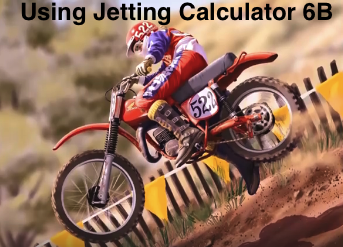 ALL MY JETTING VIDEOS: Here are the graphs I derived by testing jets and a needle/needle-jet combo for actual flow (using premix) in relation to flow area. The needle jet flow area was calculated according to the diameter of the needle at the needle jet and the diameter of the needle jet hole as the needle was tested at different needle heights. As you can see the pilot and main jets have a linear relationship between flow area and flow except for being slightly offset. 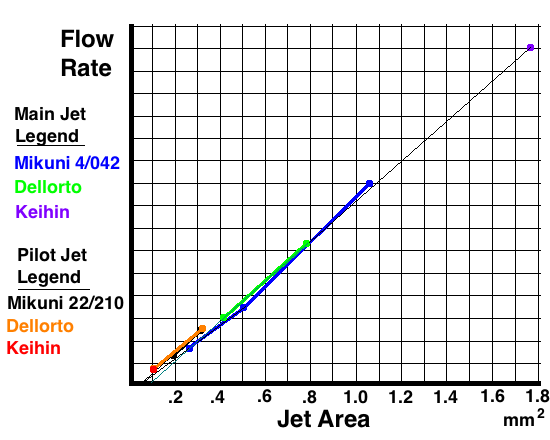 This shows how the air velocity affects suction/gas-flow: And my graph showing how the needle shroud height affects jetting: 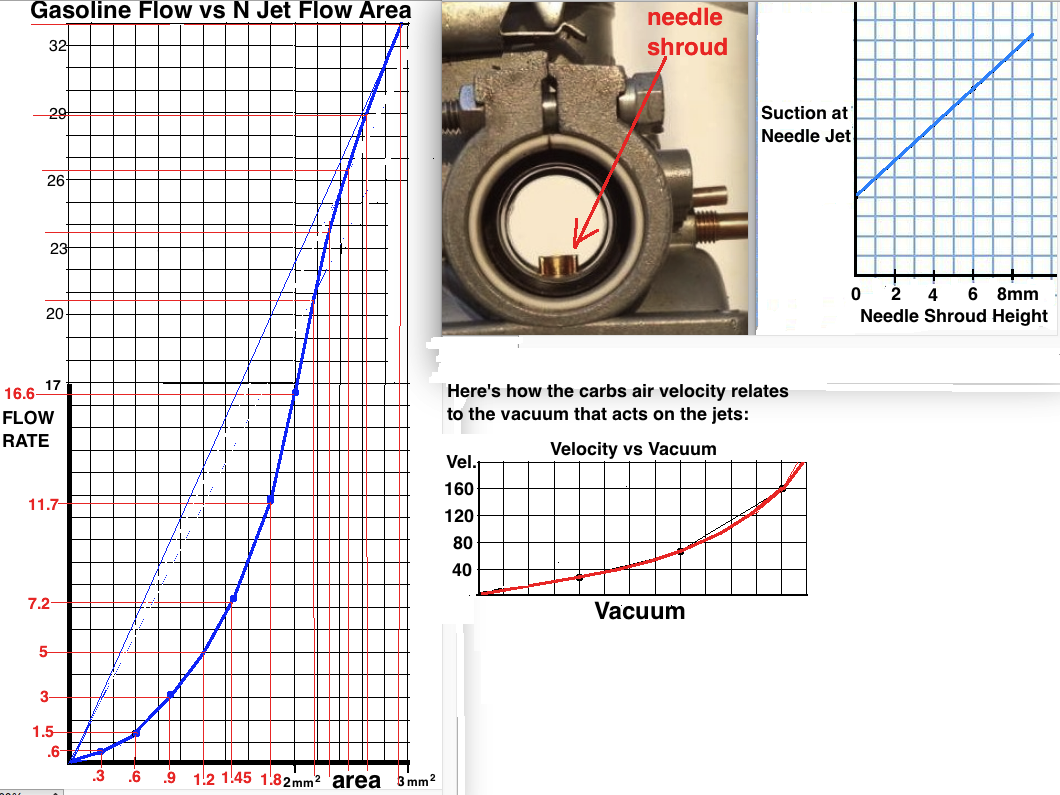 Questions & Answers HOW DOES IT BASICALLY WORK? (If after reading this you think it is over your head, just realize that how it works is all automatic within the program and doesn't require any of your brain power. Just watch these videos: #1 #2. Also you can pay me to figure it out for you if you have a digital caliper to take the measurements with.) 1) The spreadsheet relies on you first determining by trial and error what the perfect idle and main jets are and testing mid throttle jetting (how it runs). Then according to the other entered data (needle, needle height, needle jet size, slide cutaway) the program graphs your jetting and compares it to the graph of ideal jetting. 2) It takes the needle and needle jet data to calculate the flow area between them at all 8 positions of slide and calculates its effective area by a formula that simulates its non-linear flow in real life (discovered by my own testing). 3) It takes the inverse of the combined inverses of needle area and main jet area to find the effective flow area of the two combined. 4) Jetting richness of needle/main is calculated to be the effetive flow area multiplied by the calculated suction which is non-linearly related to air velocity. Those are then divided by the volume of air going thru the carb. 5) The jetting richness is further multiplied by factors derived from altitude, % ethanol, humidity, temperature, and needle shroud height. 6) The idle richness is calculated using the jet flow area, calculated suction, and front slide open area. 7) It adds together the jetting from the idle jet and the needle/main jet to arrive at total jetting richness thru the whole throtte range. 8) It compares the calculated richness with the ideal richness and then graphs the result of the difference between the two as a blue line graph. Where that graph is above 1.0 it is rich (ie: richer than what a street/trail bike needs), and below 1.0 it is lean. Is your head hurting now? Hey, you did ask! Just don't ask about my expansion chamber calculator if you don't want your head to explode. Why should I trust a calculator when any tuner will tell you that each engine is unique and will need different jetting? Yes it is true that two similar bikes will need different jetting and so the calculator takes the safest route by first requiring that you have already followed the procedure to find the perfect idle and main jet. Then enter in all the details, including the needle, and the calculator will plot the richness graph for your current jetting and you can see how it varies from the ideal jetting in between closed and open throttle. Then you can virtually try different needles, needle height, needle jets, and slide cutaways till the jetting graph is as close as possible to perfect. What is the best way to choose a main jet? Don't go by plug reading, go by max power under the highest load situation you commonly experience and then check under the piston crown to make sure the piston isn't getting too hot (evidenced by oil burnt onto it). Click here to read more about it. How do I know if my mid throttle jetting is lean or rich since both cause a power loss? If it is lean then you are forced to slowly open the throttle or else it will bog. If it is too rich then if you slowly roll on the throttle it will sound congested and may even sputter, and it prefers that you open the throttle more. How do I know this calculator is trustworthy? Fair question. I started off using it with my 100cc with Mikuni 20mm until I got the jetting perfect thru the whole range of throttle, something I had been attempting to do for 4 years but it was an impossible task without a good jetting calculator. Then I used the calculator to check a few Dellorto carbs since I know the complete setup for them and for what engines they are jetted for. Then I have Keihin jetting databases for the Kawasaki KDX200 and Husqvarna WR bikes and I checked their data and I got good agreement. OK so that is good and as much as can be determined without an absolute complete data set. And I continue to acquire jetting data which I enter into the calculator to see if the graph matches what the rider is experiencing. What if the jetting graph shows something different than what I experience when riding the bike? Then just use the graph as a reference, even if it is off from real life. Let's say the graph shows a +7% mid throttle richness that isn't there in real life (we can only feel 5% or more) and you want a needle to make it leaner or richer there. So you just virtually try different needles using the calculator and see how the graph changes there, to be even richer or leaner than the first graph. So you judge each needle you virtually try by seeing the change from the 1st graph, the relative change. Can this be used for a carburetor with a Power Jet? Yes, it can if you have one with numbered power jets. It can even calculate for the Keihin carbs with throttle position sensors that turn it on after 1/2 slide open. Does this work with piston port intake engines? Yes, absolutely. The graph it gave for my piston port engine was spot on to what I experience it while riding. What is this programs main use? To virtually experiment till the jetting is nearly perfect. Sizing the idle and main jet is an easy and straight forward process that anybody can do. Getting the needle and everything else right is what's hard. How do you know this calculator compensates correctly for elevation, % ethanol, and weather changes? Its formulas are based on data about these kinds of changes already published on the internet. You can't make stuff like that up, you have to go by already accepted scientific data. Here's my own experience: My bike was jetted perfectly with around 70% humidity. Both riding it and checking it on the jetting calculator it was right on. Next day it rained and after the rain (90% humidity) I went riding and it was just on the verge of hesitating like when it's too rich. Checked it on the calculator and it showed 4% rich. I then switched gas from 0% ethanol to 25% ethanol (which is what is typically sold here) and looked up the forecast for the next day and had to up the main jet by one size to get perfect jetting. I did that and rode it the next day and the jetting was right on. Then I switched to 10% ethanol gas and changed the main jet size by what gave perfect jetting in the calculator and riding the bike I could tell that once again the jetting was spot on. So I'm pretty confident in the calculator. 
What other carbs will this work with? There is an "old carbs" sheet for evaluating any other 2 stroke carb with a nearly round carb throat with a slide that is level (horizontal) at the bottom on the engine side. For needles with no published data you'll have to find out the needle taper angle[s]. Most of the old carbs use single taper. Then use a digital caliper to measure its diameters and taper length and enter those dimensions into the calculator. Is this only for 2 stroke carbs? Not really, just for carbs with a throttle slide. Most 4 stroke carbs have additional air holes in the sides of their needle jets which lessens the fuel flow but since the program is relative to what is known to be the correct main jet size then it should still work as long as the carb uses a slide instead of a butterfly valve. The second air velocity calculator on the Velocity sheet is for 4 stroke carbs. But it asks for volumetric efficiency which only a rare person would know about their engine because it depends on valve timing and RPM. I would put .95 for a race bike, or .85 for all other bikes which should be close enough. Where should I buy jets/needles from? The best is Treatland for Dollorto, and Niche Cycle for Mikuni and Keihin. Many other places (especially Jets-R-Us) say they sell geniune jets but they are cheap replacements and can vary greatly from the diameters/angles they are supposed to have. How does a boost bottle change jetting? The normal pre-pipe-powerband power dip has a dramatically rich mixture which the YEIS boost bottle can perfectly counter. Its effects are mostly right there although it may also cause you to need an idle jet that is richer. |
